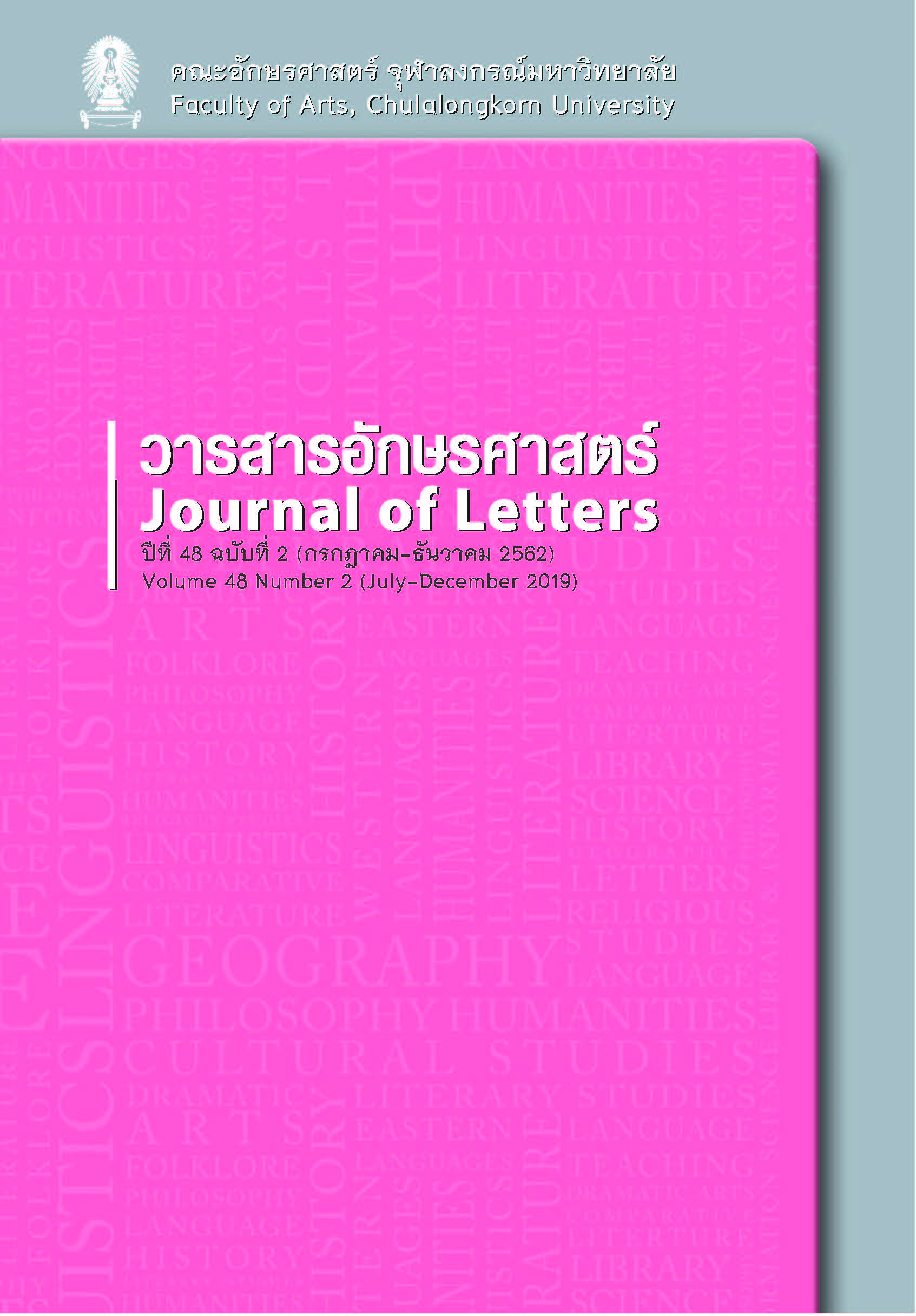Bot Lakhon Rueang Dalang Chabap Muen Chamnian: The New Discovery of an Old Version of the Dalang
Keywords:
Bot Lakhon, Dalang, Muen Chamnian, a folded paper book, Chiang MaiAbstract
Bot Lakhon Rueang Dalang Chabap Muen Chamnian, a literary work of unknown origin, was recorded in a Samut Thai, or a folded paper book, and is now kept at Chiang Mai university library. It is inscribed on the book cover that Muen Chamnian wrote the text. Bot Lakhon Rueang Dalang Chabap Muen Chamnian is a different version of Bot Lakhon Rueang Dalang of King Rama I. It starts from a scene in which Panyi enters the Manya kingdom, and moves forward to a scene in which Butsaba and Karattika disguise themselves as male dancers and make a journey in search of Panyi, their husband. This paper aims to examine the characteristics and establish the date of composition of Bot Lakhon Rueang Dalang Chabap Muen Chamnian by comparing it with the Dalang of King Rama I. The study finds that Bot Lakhon Rueang Dalang Chabap Muen Chamnian has many characteristics that are different from the Dalang of King Rama I: some contents, proper names, words and phrases are different from those in King Rama I’s Dalang; the verses for shadow puppetry (Bot Phak) are inserted in the text; certain words and Naphat songs are used, like those in Bot Lakhon composed before the Rattanakosin period. These characteristics illuminate the differences in style of performance between Bot Lakhon Rueang Dalang Chabap Muen Chamnian and the Dalang of King Rama I. They also indicate that Bot Lakhon Rueang Dalang Chabap Muen Chamnian was composed before the Dalang of King Rama I. Bot Lakhon Rueang Dalang Chabap Muen Chamnian, therefore, should be recognized as the earliest version of the Dalang in Thai literature, contributing to deeper knowledge of the history of Dalang literature.
References
Damrongrachanuphap, Somdetphrachaoborommawongthoe Kromphraya ดำรงราชานุภาพ, สมเด็จพระเจ้าบรมวงศ์เธอ กรมพระยา. 1965. Tamnan Lakhon Inao ตำนานละครอิเหนา [History of Inao Dance Drama] (4th ed.). Phra Nanakhon: Khlangwitthaya.
Chamnian, Muen จำเนียร, หมื่น. (n.d.). Inao อิเหนา [Inao]. [Black Khoi Manuscript]. Kawiniphon Roikrong/Wannakhadi กวีนิพนธ์ร้อยกรอง/วรรณคดี [Poetry/Literature] (Number 17021). Chiang Mai University Library, Chiang Mai.
Laikhram ลายคราม [Laikhram]. 1985. Chiang Mai: Chiang Mai University Bookstore.
Phutthaloetlanaphalai, Phrabatsomdetphra พุทธเลิศหล้านภาลัย, พระบาทสมเด็จพระ. 2002. Bot Lakhon Nok บทละครนอก [Lakhon Nok Plays] (10th ed.). Bangkok: Sinlapabannakhan.
Ruam Wannakhadi Ha Rueang รวมวรรณคดี 5 เรื่อง [A Collection of 5 Literary Works] (10th ed.). 2002. Bangkok: Sinlapabannakhan.
Saowanit Wingwon เสาวณิต วิงวอน. 2012. Wannakhadi Kansadang วรรณคดีการแสดง [Performance Literature] (2nd ed.). Bangkok: Department of Literature and Research Committees, Faculty of Humanities, Kasetsart University.
Taksin, Somdetphrachao ตากสิน, สมเด็จพระเจ้า. 1963. Bot Lakhon Ramakian บทละครรามเกียรติ์ [Ramakian Play]. Bangkok: Kurusapa Business Organization.
Thaneerat Jatuthasri ธานีรัตน์ จัตุทะศรี. 2018. “Muea Koet Ma Pen Sattri Cha Sanguan Praweni Hai Chamsai”: Kannamsanoe Tualakhon Ying Phuea Son Ying Nai Rueang Dalang Phraratchaniphon Ratchakan Thi Nueng เมื่อเกิดมาเป็นสตรี จะสงวนประเวณีให้แจ่มใส: การนำเสนอตัวละครหญิงเพื่อสอนหญิงในเรื่องดาหลังพระราชนิพนธ์รัชกาลที่ 1 [“Once one is born a woman, she should be careful to preserve her purity”: Representation of female characters as lessons for women in Dalang by King Rama I]. Warasan Thai Sueksa วารสารไทยศึกษา [Journal of Thai Studies] 14, 2: 151-198.
Wannakhadi Samai Krungsiayutthaya วรรณคดีสมัยกรุงศรีอยุธยา [Literature of the Ayutthaya Period]. 1983. Bangkok: Bannakit.
Downloads
Published
How to Cite
Issue
Section
License
Copyright and plagiarism
Authors are responsible for obtaining permission to use copyrighted materials from copyright owners. Authors are responsible for observing requisite copyright law when quoting or reproducing copyrighted materials. Quotations and reproductions of content from other published sources must be accompanied by a reference and all sources should be clearly listed in the references section. Quotations and reproductions of content from external sources without due attribution could be considered a severe infringement of academic conduct and may constitute a legal offence under the Copyright Act of B.E. 2537. Any legal ramifications arising from the infringement of copyright regulations would be the sole responsibility of the author(s).



